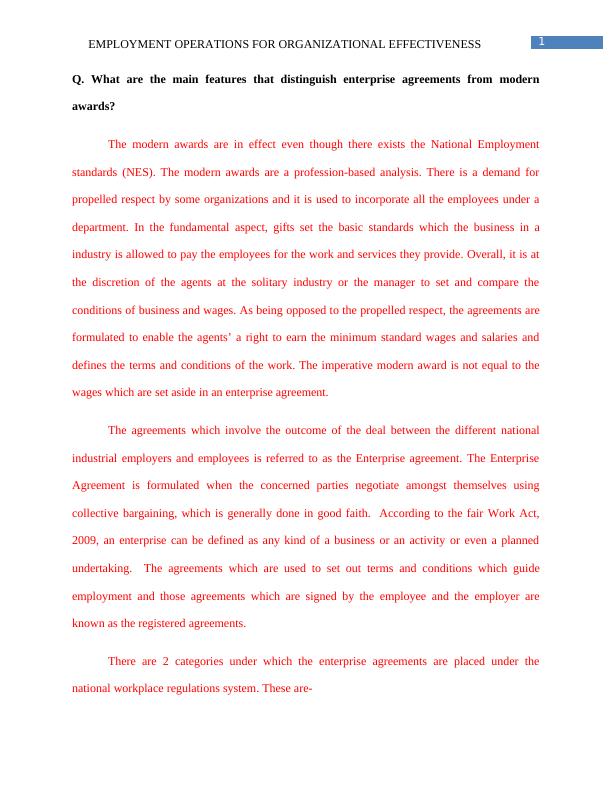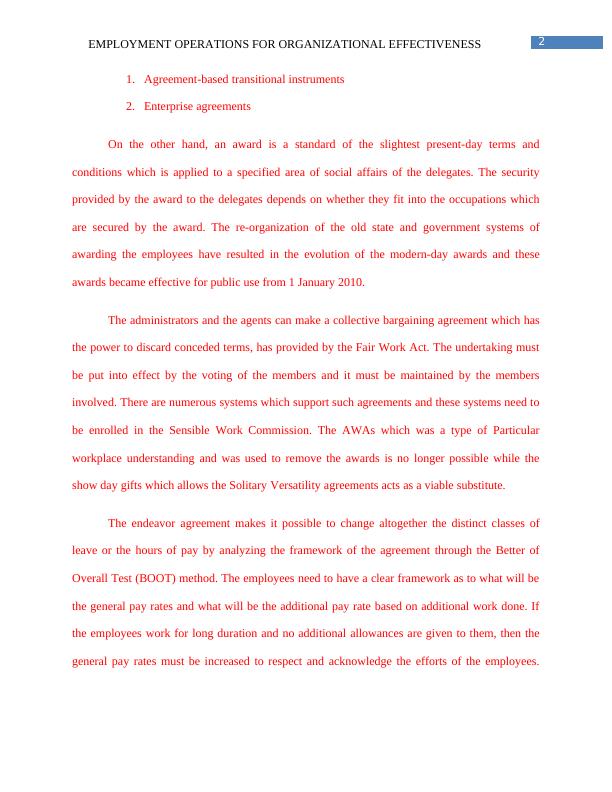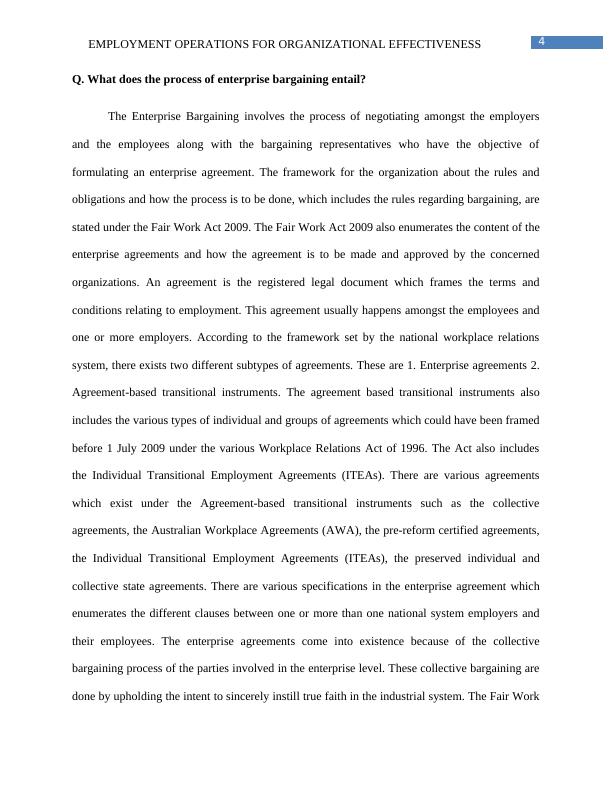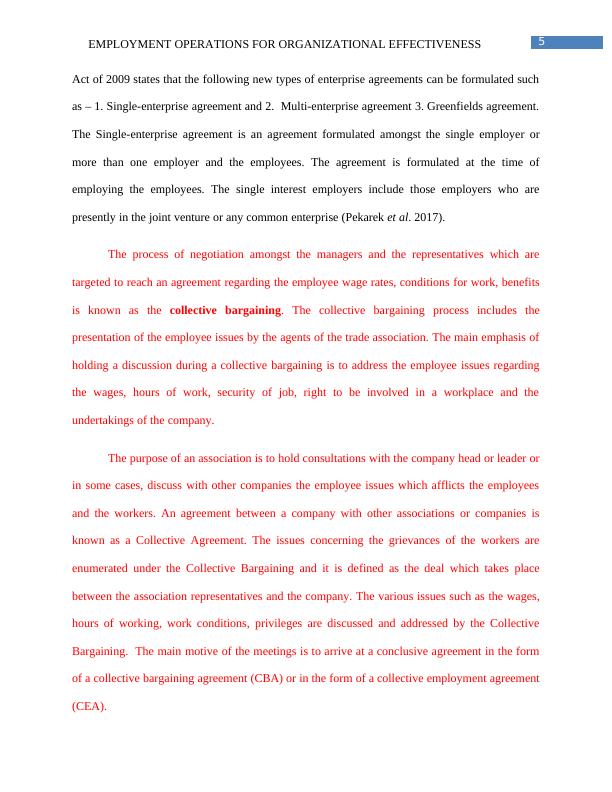Organizational Effectiveness - Assignment
Added on 2021-06-14
22 Pages5505 Words18 Views
Running Head: EMPLOYMENT OPERATIONS FOR ORGANIZATIONAL
EFFECTIVENESS
EMPLOYMENT OPERATIONS FOR ORGANIZATIONAL EFFECTIVENESS
NAME OF THE STUDENT
NAME OF THE UNIVERSITY
AUTHOR’S NOTE
EFFECTIVENESS
EMPLOYMENT OPERATIONS FOR ORGANIZATIONAL EFFECTIVENESS
NAME OF THE STUDENT
NAME OF THE UNIVERSITY
AUTHOR’S NOTE

1EMPLOYMENT OPERATIONS FOR ORGANIZATIONAL EFFECTIVENESS
Q. What are the main features that distinguish enterprise agreements from modern
awards?
The modern awards are in effect even though there exists the National Employment
standards (NES). The modern awards are a profession-based analysis. There is a demand for
propelled respect by some organizations and it is used to incorporate all the employees under a
department. In the fundamental aspect, gifts set the basic standards which the business in a
industry is allowed to pay the employees for the work and services they provide. Overall, it is at
the discretion of the agents at the solitary industry or the manager to set and compare the
conditions of business and wages. As being opposed to the propelled respect, the agreements are
formulated to enable the agents’ a right to earn the minimum standard wages and salaries and
defines the terms and conditions of the work. The imperative modern award is not equal to the
wages which are set aside in an enterprise agreement.
The agreements which involve the outcome of the deal between the different national
industrial employers and employees is referred to as the Enterprise agreement. The Enterprise
Agreement is formulated when the concerned parties negotiate amongst themselves using
collective bargaining, which is generally done in good faith. According to the fair Work Act,
2009, an enterprise can be defined as any kind of a business or an activity or even a planned
undertaking. The agreements which are used to set out terms and conditions which guide
employment and those agreements which are signed by the employee and the employer are
known as the registered agreements.
There are 2 categories under which the enterprise agreements are placed under the
national workplace regulations system. These are-
Q. What are the main features that distinguish enterprise agreements from modern
awards?
The modern awards are in effect even though there exists the National Employment
standards (NES). The modern awards are a profession-based analysis. There is a demand for
propelled respect by some organizations and it is used to incorporate all the employees under a
department. In the fundamental aspect, gifts set the basic standards which the business in a
industry is allowed to pay the employees for the work and services they provide. Overall, it is at
the discretion of the agents at the solitary industry or the manager to set and compare the
conditions of business and wages. As being opposed to the propelled respect, the agreements are
formulated to enable the agents’ a right to earn the minimum standard wages and salaries and
defines the terms and conditions of the work. The imperative modern award is not equal to the
wages which are set aside in an enterprise agreement.
The agreements which involve the outcome of the deal between the different national
industrial employers and employees is referred to as the Enterprise agreement. The Enterprise
Agreement is formulated when the concerned parties negotiate amongst themselves using
collective bargaining, which is generally done in good faith. According to the fair Work Act,
2009, an enterprise can be defined as any kind of a business or an activity or even a planned
undertaking. The agreements which are used to set out terms and conditions which guide
employment and those agreements which are signed by the employee and the employer are
known as the registered agreements.
There are 2 categories under which the enterprise agreements are placed under the
national workplace regulations system. These are-

2EMPLOYMENT OPERATIONS FOR ORGANIZATIONAL EFFECTIVENESS
1. Agreement-based transitional instruments
2. Enterprise agreements
On the other hand, an award is a standard of the slightest present-day terms and
conditions which is applied to a specified area of social affairs of the delegates. The security
provided by the award to the delegates depends on whether they fit into the occupations which
are secured by the award. The re-organization of the old state and government systems of
awarding the employees have resulted in the evolution of the modern-day awards and these
awards became effective for public use from 1 January 2010.
The administrators and the agents can make a collective bargaining agreement which has
the power to discard conceded terms, has provided by the Fair Work Act. The undertaking must
be put into effect by the voting of the members and it must be maintained by the members
involved. There are numerous systems which support such agreements and these systems need to
be enrolled in the Sensible Work Commission. The AWAs which was a type of Particular
workplace understanding and was used to remove the awards is no longer possible while the
show day gifts which allows the Solitary Versatility agreements acts as a viable substitute.
The endeavor agreement makes it possible to change altogether the distinct classes of
leave or the hours of pay by analyzing the framework of the agreement through the Better of
Overall Test (BOOT) method. The employees need to have a clear framework as to what will be
the general pay rates and what will be the additional pay rate based on additional work done. If
the employees work for long duration and no additional allowances are given to them, then the
general pay rates must be increased to respect and acknowledge the efforts of the employees.
1. Agreement-based transitional instruments
2. Enterprise agreements
On the other hand, an award is a standard of the slightest present-day terms and
conditions which is applied to a specified area of social affairs of the delegates. The security
provided by the award to the delegates depends on whether they fit into the occupations which
are secured by the award. The re-organization of the old state and government systems of
awarding the employees have resulted in the evolution of the modern-day awards and these
awards became effective for public use from 1 January 2010.
The administrators and the agents can make a collective bargaining agreement which has
the power to discard conceded terms, has provided by the Fair Work Act. The undertaking must
be put into effect by the voting of the members and it must be maintained by the members
involved. There are numerous systems which support such agreements and these systems need to
be enrolled in the Sensible Work Commission. The AWAs which was a type of Particular
workplace understanding and was used to remove the awards is no longer possible while the
show day gifts which allows the Solitary Versatility agreements acts as a viable substitute.
The endeavor agreement makes it possible to change altogether the distinct classes of
leave or the hours of pay by analyzing the framework of the agreement through the Better of
Overall Test (BOOT) method. The employees need to have a clear framework as to what will be
the general pay rates and what will be the additional pay rate based on additional work done. If
the employees work for long duration and no additional allowances are given to them, then the
general pay rates must be increased to respect and acknowledge the efforts of the employees.

3EMPLOYMENT OPERATIONS FOR ORGANIZATIONAL EFFECTIVENESS
The organizations can clearly mention the social affairs with huge business agreements or can
comprehend the details with the workers in a clear manner.
Modern awards establish the minimum eligibility criteria for the employees to be able to
obtain entitlements. All the employees who are employed in the industry are eligible for modern
awards. The only exception is the employees come under the enterprise agreement. The scenario
wherein the employees were covered under the enterprise agreement, but the agreement ceases to
exist, then the employees will again be eligible for modern award again. The modern awards
include the criteria for the employees to follow so that they can ascertain the entitlement s which
they are supposed to get from the industry. In Australia, there are about 122 modern awards
covering most of the occupations and the industrial activities. The entitlements which are less
than the National Employment Standards (NES) and offer less benefits to the employees are not
included in the Modern awards. There is a total of 10 minimum standards relating to employment
which are included in the accounting of the National Employment Standards (NES) and it is
applicable to all the employers and the employees who are covered under the Fair Worker Act of
2009. The Modern awards addresses the following issues such as the minimum wage rates, the
penalty rates which are to be included for overtime and weekend work, the decision regarding
leaves and the allowances to be paid. The modern award is applicable to all the employees who
are employed in the industrial activities although it sometimes becomes difficult for the
ascertainment of the enterprise agreements in the long run. According to the Fair Work Act of
2009, the modern awards are the documents which are legally written outlining the minimum
wage rate and the conditions of the employment to be followed by the employers. There are in
total about 122 industries in Australia which are covered by the Modern awards in Australia.
The Modern Awards makes the entitlements such as the pay, the hours of work.
The organizations can clearly mention the social affairs with huge business agreements or can
comprehend the details with the workers in a clear manner.
Modern awards establish the minimum eligibility criteria for the employees to be able to
obtain entitlements. All the employees who are employed in the industry are eligible for modern
awards. The only exception is the employees come under the enterprise agreement. The scenario
wherein the employees were covered under the enterprise agreement, but the agreement ceases to
exist, then the employees will again be eligible for modern award again. The modern awards
include the criteria for the employees to follow so that they can ascertain the entitlement s which
they are supposed to get from the industry. In Australia, there are about 122 modern awards
covering most of the occupations and the industrial activities. The entitlements which are less
than the National Employment Standards (NES) and offer less benefits to the employees are not
included in the Modern awards. There is a total of 10 minimum standards relating to employment
which are included in the accounting of the National Employment Standards (NES) and it is
applicable to all the employers and the employees who are covered under the Fair Worker Act of
2009. The Modern awards addresses the following issues such as the minimum wage rates, the
penalty rates which are to be included for overtime and weekend work, the decision regarding
leaves and the allowances to be paid. The modern award is applicable to all the employees who
are employed in the industrial activities although it sometimes becomes difficult for the
ascertainment of the enterprise agreements in the long run. According to the Fair Work Act of
2009, the modern awards are the documents which are legally written outlining the minimum
wage rate and the conditions of the employment to be followed by the employers. There are in
total about 122 industries in Australia which are covered by the Modern awards in Australia.
The Modern Awards makes the entitlements such as the pay, the hours of work.

4EMPLOYMENT OPERATIONS FOR ORGANIZATIONAL EFFECTIVENESS
Q. What does the process of enterprise bargaining entail?
The Enterprise Bargaining involves the process of negotiating amongst the employers
and the employees along with the bargaining representatives who have the objective of
formulating an enterprise agreement. The framework for the organization about the rules and
obligations and how the process is to be done, which includes the rules regarding bargaining, are
stated under the Fair Work Act 2009. The Fair Work Act 2009 also enumerates the content of the
enterprise agreements and how the agreement is to be made and approved by the concerned
organizations. An agreement is the registered legal document which frames the terms and
conditions relating to employment. This agreement usually happens amongst the employees and
one or more employers. According to the framework set by the national workplace relations
system, there exists two different subtypes of agreements. These are 1. Enterprise agreements 2.
Agreement-based transitional instruments. The agreement based transitional instruments also
includes the various types of individual and groups of agreements which could have been framed
before 1 July 2009 under the various Workplace Relations Act of 1996. The Act also includes
the Individual Transitional Employment Agreements (ITEAs). There are various agreements
which exist under the Agreement-based transitional instruments such as the collective
agreements, the Australian Workplace Agreements (AWA), the pre-reform certified agreements,
the Individual Transitional Employment Agreements (ITEAs), the preserved individual and
collective state agreements. There are various specifications in the enterprise agreement which
enumerates the different clauses between one or more than one national system employers and
their employees. The enterprise agreements come into existence because of the collective
bargaining process of the parties involved in the enterprise level. These collective bargaining are
done by upholding the intent to sincerely instill true faith in the industrial system. The Fair Work
Q. What does the process of enterprise bargaining entail?
The Enterprise Bargaining involves the process of negotiating amongst the employers
and the employees along with the bargaining representatives who have the objective of
formulating an enterprise agreement. The framework for the organization about the rules and
obligations and how the process is to be done, which includes the rules regarding bargaining, are
stated under the Fair Work Act 2009. The Fair Work Act 2009 also enumerates the content of the
enterprise agreements and how the agreement is to be made and approved by the concerned
organizations. An agreement is the registered legal document which frames the terms and
conditions relating to employment. This agreement usually happens amongst the employees and
one or more employers. According to the framework set by the national workplace relations
system, there exists two different subtypes of agreements. These are 1. Enterprise agreements 2.
Agreement-based transitional instruments. The agreement based transitional instruments also
includes the various types of individual and groups of agreements which could have been framed
before 1 July 2009 under the various Workplace Relations Act of 1996. The Act also includes
the Individual Transitional Employment Agreements (ITEAs). There are various agreements
which exist under the Agreement-based transitional instruments such as the collective
agreements, the Australian Workplace Agreements (AWA), the pre-reform certified agreements,
the Individual Transitional Employment Agreements (ITEAs), the preserved individual and
collective state agreements. There are various specifications in the enterprise agreement which
enumerates the different clauses between one or more than one national system employers and
their employees. The enterprise agreements come into existence because of the collective
bargaining process of the parties involved in the enterprise level. These collective bargaining are
done by upholding the intent to sincerely instill true faith in the industrial system. The Fair Work

5EMPLOYMENT OPERATIONS FOR ORGANIZATIONAL EFFECTIVENESS
Act of 2009 states that the following new types of enterprise agreements can be formulated such
as – 1. Single-enterprise agreement and 2. Multi-enterprise agreement 3. Greenfields agreement.
The Single-enterprise agreement is an agreement formulated amongst the single employer or
more than one employer and the employees. The agreement is formulated at the time of
employing the employees. The single interest employers include those employers who are
presently in the joint venture or any common enterprise (Pekarek et al. 2017).
The process of negotiation amongst the managers and the representatives which are
targeted to reach an agreement regarding the employee wage rates, conditions for work, benefits
is known as the collective bargaining. The collective bargaining process includes the
presentation of the employee issues by the agents of the trade association. The main emphasis of
holding a discussion during a collective bargaining is to address the employee issues regarding
the wages, hours of work, security of job, right to be involved in a workplace and the
undertakings of the company.
The purpose of an association is to hold consultations with the company head or leader or
in some cases, discuss with other companies the employee issues which afflicts the employees
and the workers. An agreement between a company with other associations or companies is
known as a Collective Agreement. The issues concerning the grievances of the workers are
enumerated under the Collective Bargaining and it is defined as the deal which takes place
between the association representatives and the company. The various issues such as the wages,
hours of working, work conditions, privileges are discussed and addressed by the Collective
Bargaining. The main motive of the meetings is to arrive at a conclusive agreement in the form
of a collective bargaining agreement (CBA) or in the form of a collective employment agreement
(CEA).
Act of 2009 states that the following new types of enterprise agreements can be formulated such
as – 1. Single-enterprise agreement and 2. Multi-enterprise agreement 3. Greenfields agreement.
The Single-enterprise agreement is an agreement formulated amongst the single employer or
more than one employer and the employees. The agreement is formulated at the time of
employing the employees. The single interest employers include those employers who are
presently in the joint venture or any common enterprise (Pekarek et al. 2017).
The process of negotiation amongst the managers and the representatives which are
targeted to reach an agreement regarding the employee wage rates, conditions for work, benefits
is known as the collective bargaining. The collective bargaining process includes the
presentation of the employee issues by the agents of the trade association. The main emphasis of
holding a discussion during a collective bargaining is to address the employee issues regarding
the wages, hours of work, security of job, right to be involved in a workplace and the
undertakings of the company.
The purpose of an association is to hold consultations with the company head or leader or
in some cases, discuss with other companies the employee issues which afflicts the employees
and the workers. An agreement between a company with other associations or companies is
known as a Collective Agreement. The issues concerning the grievances of the workers are
enumerated under the Collective Bargaining and it is defined as the deal which takes place
between the association representatives and the company. The various issues such as the wages,
hours of working, work conditions, privileges are discussed and addressed by the Collective
Bargaining. The main motive of the meetings is to arrive at a conclusive agreement in the form
of a collective bargaining agreement (CBA) or in the form of a collective employment agreement
(CEA).

End of preview
Want to access all the pages? Upload your documents or become a member.
Related Documents
Better Off Overall Test: Enterprise Agreements vs Modern Awardslg...
|10
|2801
|34
Understanding Employment Relations and Intellectual Property Policies in Star Industrieslg...
|9
|2163
|83
Modern Awards: Ensuring Minimum Entitlements for Employeeslg...
|6
|1332
|79
Enterprise Agreements and the Better Off Overall Testlg...
|6
|896
|85
ENTERPRISE AGREEMENT.lg...
|3
|401
|56
Employment Relation in Australialg...
|7
|2118
|47
